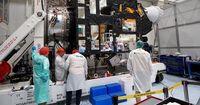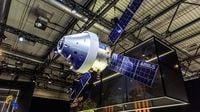In a move set to reshape the competitive landscape of the global space industry, three of Europe’s top aerospace giants—Airbus, Leonardo, and Thales—have agreed to merge their space divisions into a single, unified powerhouse. Announced on October 23, 2025, and internally dubbed “Project Bromo,” this ambitious joint venture aims to consolidate Europe’s fragmented space sector, boost innovation, and position the continent as a formidable rival to established U.S. players like SpaceX and Northrop Grumman.
The proposed merger, formalized through a memorandum of understanding (MOU), will bring together the satellite and space service operations of the three companies, uniting approximately 25,000 employees and generating an estimated €6.5 billion in annual revenue based on 2024 figures. The ownership structure will see Airbus holding a 35% stake, with Leonardo and Thales each taking 32.5%. The new entity, expected to begin operations in 2027, is still subject to regulatory approval and detailed negotiations, but its announcement has already sent ripples through the industry.
According to European Spaceflight, the new company will combine the Space Systems and Space Digital divisions of Airbus Defence and Space, Leonardo’s Space Division (including its stakes in Telespazio and Thales Alenia Space), and Thales’s holdings in Thales Alenia Space, Telespazio, and optics firm Thales SESO. The venture will be managed under what executives describe as a “balanced governance structure,” aiming to ensure joint control and equitable decision-making across the three parent firms.
For context, the combined revenue of the new European space behemoth still trails behind some of its American counterparts. SpaceX, for example, is estimated to have generated $13.1 billion in 2024, while Northrop Grumman’s Space Systems segment brought in $11.7 billion. Still, the merger signals Europe’s intent to close the gap and assert greater autonomy in critical space technologies.
Josef Aschbacher, Director General of the European Space Agency (ESA), welcomed the consolidation, saying during a press conference at the 337th ESA Council meeting in Paris that the merger would “make industry stronger and therefore more competitive on the world market.” However, not all ESA leaders are equally enthusiastic. Rolf Densing, ESA’s Director of Operations, told Reuters, “Having only one in the future is not too helpful. On the other hand, they need a critical mass of business, which I perfectly understand.” This highlights a tension between the desire for streamlined competitiveness and concerns over reduced supplier diversity in Europe’s space ecosystem.
The drive toward consolidation is rooted in a rapidly changing industry landscape. The rise of private sector disruptors, most notably Elon Musk’s Starlink (operated by SpaceX), has upended traditional satellite operators by deploying massive low-Earth-orbit (LEO) constellations, offering high-speed global internet, and scaling at an unprecedented pace. According to FlightPlan, the European merger is a direct response to these pressures, with the new alliance aiming to leverage Europe’s industrial base, regulatory environment, and institutional demand to carve out a larger share of the satellite connectivity market.
The new joint venture will focus on end-to-end space infrastructure and services, excluding launch vehicles. Its ambitions are broad: delivering high-throughput broadband, IoT connectivity, and secure government communications—not just to urban centers, but to remote regions, maritime zones, and governmental customers. The intention is to create a vertically integrated challenger capable of competing not only on hardware but also on service pricing, regulatory alignment, and customer trust, particularly in sovereign supply chains.
Guillaume Faury, CEO of Airbus, previously commented on the rationale for the merger, noting the accelerating pace of change in the sector. He stated that combining capabilities is about “leveraging combined resources to adapt further to future markets with modularity, faster production, and more agile responses.” Faury also highlighted Europe’s push for greater independence in space missions, observing that many European and global missions currently rely heavily on SpaceX due to its low operating costs. By joining forces, Airbus, Leonardo, and Thales hope to offer competitive costs and reduce European dependence on non-European providers.
The merger is expected to generate mid-triple-digit million euro annual synergies within five years of closing, largely through operational efficiencies in engineering, manufacturing, and project management, as reported by Forecast International. The combined order backlog already covers more than three years of projected sales, giving the new entity a strong foundation for future growth.
The consolidation is poised to impact several key European space programs. The new company could take a leading role in the development and sustainment of Galileo and EGNOS (Europe’s navigation systems), become a principal contractor for Copernicus Earth observation programs, and consolidate assets for defense and secure communications projects such as GOVSATCOM and IRIS². National military satellite programs—including France’s Syracuse, Italy’s SICRAL, and the UK’s Skynet—may also benefit from shared technology development and cost efficiencies.
Yet, not every European player is on board. OHB, a German aerospace company with a strong satellite pedigree, remains independent and continues to lead initiatives like the Odin’s Eye missile warning system. This positions OHB as both a competitor and a potential collaborator in the evolving European space landscape.
Despite the optimism, challenges loom. Regulatory approval is far from guaranteed, as past consolidation attempts in the aerospace and defense sectors have faced scrutiny over market dominance, procurement fairness, and national strategic interests. Each company also brings distinct national obligations, product lines, and corporate cultures, all of which will need to be harmonized for the merger to succeed. Financial hurdles are also present; Airbus’s space division, for instance, has faced costly overruns on projects like OneSat, a reprogrammable GEO satellite effort.
Nevertheless, the parent companies and many European officials see this merger as a necessary leap forward. As the space sector becomes more competitive and strategic, Europe’s ability to defend its interests, foster innovation, and maintain a seat at the global table may well depend on bold, unified action. With Project Bromo, Airbus, Leonardo, and Thales are betting that together, they can build a European space champion fit for the challenges—and opportunities—of the next frontier.






